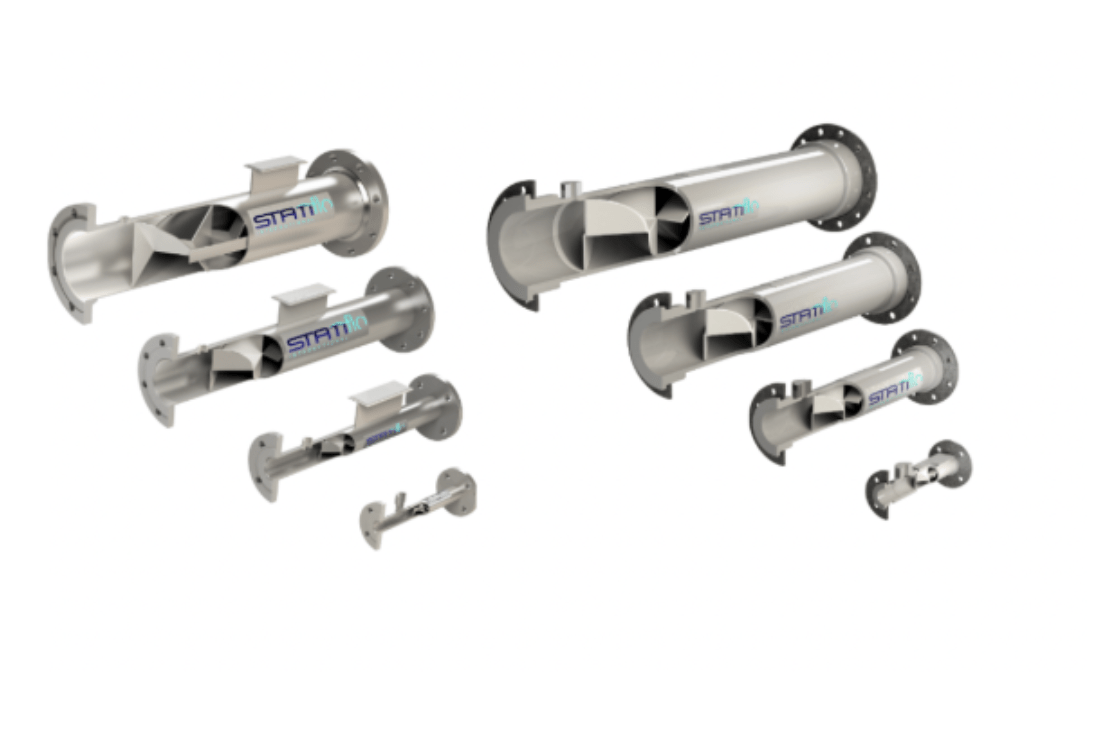
A Statiflo Mini-Guide: The Different Types Of Static Mixers We Offer
Pipe Static Mixers
There are Two Primary Configurations for Pipe Static Mixers:
-
Fixed mixing elements which are permanently installed inside the pipe and are ideal for applications where the mixing requirements are consistent and the need for maintenance minimal.
-
Removable mixing elements which are designed for processes that may require cleaning or periodic maintenance, or hygienic/santiary applications where the presence of internal welds should be avoided.
Applications
Benefits of Pipe Static Mixers
-
High efficiency in mixing without moving parts.
-
Can handle a variety of fluid viscosities.
-
Low maintenance due to the absence of mechanical components.
-
Available in a range of materials, including stainless steel and other corrosion-resistant alloys, to suit different industrial environments.
Channel and Duct Static Mixers
Our channel and duct static mixers, which are specifically designed for use in open channels and closed duct systems, are particularly suited for the water and wastewater treatment industries. The ability to provide homogeneous mixing with minimal pressure loss makes them ideal for these large-scale applications.
Applications
-
Water treatment plants: Effective when mixing chemicals, such as coagulants and disinfectants, into water.
-
Wastewater treatment facilities: Used for mixing flocculants, pH adjustment chemicals, and other additives.
-
Industrial effluent treatment: Help in blending chemical treatments into waste streams for effective neutralisation and processing.
Benefits of Channel and Duct Static Mixers
-
Designed for low-pressure drop to maintain energy efficiency in large-scale applications.
-
Handles high-volume flow rates in open-channel operations.
-
Requires minimal maintenance, as there are no moving parts that wear and require disruptive maintenance or replacement.
-
Customisable to fit various channel or duct dimensions.
Desalination Mixers
In the desalination industry, efficient mixing with minimal energy consumption is critical. Our desalination mixers, also known as compact or short-length static mixers, are designed with these specific requirements in mind. Highly efficient, they enabling precise mixing with minimal dosing of additives, making them ideal for desalination processes where the quality of the final water output matters.
Applications
Benefits of Desalination Mixers
-
Extremely efficient at dosing and mixing chemicals, resulting in cost savings.
-
Compact design means they can fit into smaller spaces without sacrificing performance.
-
Minimises energy consumption and pressure drop, which is crucial to maintain the efficiency of desalination processes.
-
Reduces chemical usage by providing highly efficient mixing, which is crucial in a cost-sensitive industry such as desalination.
Custody Transfer Mixers
Custody transfer applications require a high degree of precision and consistency in the mixing process to ensure that the product being transferred meets the required standards. Our custody transfer mixers are specifically designed to achieve this, consistently meeting ISO 3171 and API 8.2 standards, which require that the C1/C2 ratio (a measure of the mixing effectiveness) is greater than 0.9.
Applications
Custody transfer mixers are ideal for:
-
Oil and gas custody transfer processes, in which they ensure that fluids - crude oil, refined petroleum, or natural gas - are uniformly mixed before measurement or transfer.
Benefits of Custody Transfer Mixers
-
Achieves a highly consistent C1/C2 ratio above 0.9, ensuring compliance with international standards.
-
Reduces measurement uncertainty in custody transfer, leading to more accurate fiscal metering and fewer disputes.
-
Requires minimal maintenance due to its static, non-moving design.
-
Available in a range of materials to withstand the harsh environments that are often found in the oil and gas industry.
Gas Dispersion Systems
Applications
-
Water treatment: Dissolving oxygen or ozone into water for aeration or disinfection.
-
Chemical processing: Efficient gas-liquid mixing for reactions, such as hydrogenation.
-
Food and beverage: Dissolving gases into liquids for carbonation or aeration purposes.
Benefits of Gas Dispersion Mixers
-
Enhanced mass transfer efficiency, leading to more effective gas dissolution.
-
Can handle a wide variety of gases and liquids.
-
Low maintenance and long service life
-
Customisable design for specific application needs, such as varying flow rates and gas compositions.
Find Our More From the Experts at Statiflo


